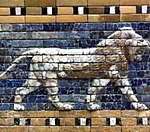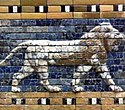Rullesegl

Rullesegl er en lille rund cylinder, typisk ca. en tomme (2-3 cm) i længde, indgraveret med skriftlige tegn eller figurbilleder eller begge dele, brugt i gamle tider til at rulle et indtryk på en todimensionel overflade, som regel vådt ler. Rullesegl blev opfundet omkring 3.500 f.Kr. i Nærorienten, i de datidige stæder i Uruk i det sydlige Mesopotamien og lidt senere i Susa i det sydvestlige Iran i den proto-elamitiske periode, og de følger udviklingen for stempelsegl i Halaf-kulturen eller lidt tidligere.[5] De hænger sammen med opfindelsen af kileskrift på lertavler.[6][7][8] De blev brugt som et administrativt værktøj, en form for underskrift såvel som smykker og som magiske amuletter;[9] senere versioner ville anvende notationer med mesopotamisk kileskrift. I senere perioder blev de brugt for at notarisere eller attestere flere typer af skriftlige lerdokumenter. Grave og andre steder, der husede dyrebare genstande som guld, sølv, perler og ædelstene rummer ofte en eller to rullesegl som ærefulde gravgaver.
Beskrivelse
Selve rulleseglene er typisk lavet af hårde stenarter, og nogle er en form for graveret gemme. De kan i stedet bruge glas eller keramik, som egyptisk fajance. Mange varianter af materiale såsom hematit, obsidian, steatit, ametyst, lapis lazuli og karneol blev brugt til at fremstille rullesegl. Da det alluviale land Mesopotamia mangler gode sten til udskæring, blev de store sten til tidlige rullesegl sandsynligvis importeret fra Iran.[7] De fleste segl har et hul, der løber gennem midten af seglkroppen, og det menes, at de typisk er blevet båret i en halskæde, så de altid var tilgængelige, når det var nødvendigt.

Mens de fleste mesopotamiske rullesegl danner et billede ved hjælp af fordybninger i cylinderoverfladen, udskriver nogle rullesegl deres motiver ved hjælp af hævede områder på cylinderen (fx San Andrés-rulleseglet, som ikke er relateret til mesopotamiske rullesegl). Førstnævnte anvendes primært på våde lerarter; sidstnævnte, undertiden benævnt rullestempler, bruges til at udskrive billeder på klæde og andre lignende todimensionale overflader.
Rullesegl er en form for aftrykssegl, en kategori, der også omfater stempelforsegling og fingerringsforsegling. De overlever i ret store antal og er ofte vigtige som kunst, især i de babylonske og tidligere assyriske perioder. Indtryk af et blødt materiale kan tages uden risiko for beskadigelse af seglet, og de vises ofte på museer sammen med et moderne indtryk på en lille lerplade.
Noter
- ^ "Cylinder Seal with a Nude Goddess". The Walters Art Museum.
- ^ British Museum notice WA 121544
- ^ Crawford, Harriet (2013). The Sumerian World (engelsk). Routledge. s. 622. ISBN 9781136219115.
- ^ Anthropology, University of Pennsylvania Museum of Archaeology and; Hansen, Donald P.; Pittman, Holly (1998). Treasures from the Royal Tombs of Ur (engelsk). UPenn Museum of Archaeology. s. 78. ISBN 9780924171550.
- ^ Brown, Brian A.; Feldman, Marian H. (2013). Critical Approaches to Ancient Near Eastern Art (engelsk). Walter de Gruyter. s. 304. ISBN 9781614510352.
- ^ Mesopotamian cylinder seals, British Museum
- ^ a b Why Cylinder Seals? Engraved Cylindrical Seal Stones of the Ancient Near East, Fourth to First Millennium B.C., by Edith Porada © 1993 College Art Association., The Art Bulletin, Vol. 75, No. 4 (Dec., 1993), pp. 563-582, JSTOR
- ^ Ancient cylinder seal found in Iran Arkiveret 2. juni 2013 hos Wayback Machine, 2 March 2009, Press TV
- ^ "Ancient Cylinder Seals". Johns Hopkins Archaeological Museum. Johns Hopkins University. Arkiveret fra originalen 30. juni 2019. Hentet 12. juni 2019.
Litteratur
- Bahn, Paul. Lost Treasures, Great Discoveries in World Archaeology, Ed. by Paul G. Bahn, (Barnes and Noble Books, New York), c 1999. Examples of, or discussions of Stamp seals, cylinder seals and a metal stamp seal.
- Collon, Dominique. First Impressions, Cylinder Seals in the Ancient Near East, (British Museum Press, London), 1987, 2005. Very comprehensive and up to date account, with many illustrations. The author has compiled several of the volumes cataloging the collection of cylinder seals in the British Museum.
- Collon, Dominique. Near Eastern Seals, (British Museum, London), 1990. Shorter account which also includes stamp seals . Part of the BM's Interpreting the Past series
- Frankfort, H. Cylinder Seals, 1939, London. A classic, though obviously doesn't reflect later research.
- Garbini, Giovanni. Landmarks of the World's Art, The Ancient World, by Giovanni Garbini, (McGraw-Hill Book Company, New York, Toronto), General Eds, Bernard S. Myers, New York, Trewin Copplestone, London, c 1966. "Discussion, or pictures of about 25 cylinder seals"; also lists the "Scaraboid seal", an impression seal (needs to be a mirror/reverse to be an impression seal).
- Metropolitan Museum of Art. Cuneiform Texts in the Metropolitan Museum of Art: Tablets, Cones, and Bricks of the Third and Second Millennia B.C., vol. 1 (New York, 1988). The final section (Bricks) of the book concerns cylinder Seals, with a foreword describing the purpose of the section as to instigate Research into cylinder Seals. The 'cylinder sealing' on the bricks, was done multiple times per brick. Some are of high quality, and some are not. (Also contains the only 2 el Amarna letters, in the USA, with Analysis.)
- Metropolitan Museum of Art. Ancient Near Eastern Art, (Reprint), Metr. Mus. of Art Photograph Studio, Designed, Alvin Grossman, Photography, Lynton Gardiner, (Metropolitan Museum of Art Bulletin (Spring 1984)), c 1984. 56pgs.
- Metropolitan Museum of Art. Beyond Babylon, Art, Trade and Diplomacy in the Second Millennium BC, ed. Joan Aruz. 2008. Many cylinder seals of the period illustrated in color with impressions and descriptions.
- National Geogr. Soc. Wonders of the Ancient World; National Geographic Atlas of Archeology, Norman Hammond, Consultant, Nat'l Geogr. Soc., (Multiple Staff authors), (Nat'l Geogr., R.H.Donnelley & Sons, Willard, OH), 1994, 1999, Reg. or Deluxe Ed. Origins of Writing, section, pp 68–75. Akkadian Cylinder seal, with its modern seal impression. p. 71.
- Robinson, Andrew. The Story of Writing, Andrew Robinson, (Thames and Hudson), c 1995, paperback ed., c 1999. (Page 70, Chapter 4: Cuneiform) Ur-Nammu cylinder seal (and impression), with 2095 BCE hieroglyphs, 2X-3X; Darius I, impression only, of chariot hunting scene, 2X, ca 500 BCE.
| |||||||||||||||||||||||||||||||||||||||||||||||||||||||||
|
Medier brugt på denne side
Cylinder seal and sealing impression: the king-priest and his acolyte feeding the sacred herd. White limestone, Uruk period, ca. 3200 BC.
Under a canopy, a worshiper faces a deity- possibly Ishtar, goddess of fertility- on a raised platform. Two winged genii (protective deities) holding ceremonial buckets flank the central scene, and divine astral symbols appear above. A three-line inscription gives the name and titles of the owner: "[seal] of Nabu-nurka-lamur, superintendent of Ahu-shamshi, the palace herald." The finely drilled style of this seal dates it to the 9th or 8th century BC.
Forfatter/Opretter: Hjaltland Collection, Licens: CC BY-SA 3.0
The king with a mace, who stands on a rectangular chequer-board dais, follows the suppliant goddess (with necklace counterweight), and the robed king with an animal offering. They stand before the ascending Sun god who holds a saw-toothed blade and rests his foot on a couchant human-headed bull (full face).
Traces remain of an inscription (probably of four lines) erased in antiquity.
The style of this seal suggests that it was made in a Sippar workshop.
Haematite; chipped. 3.05 x 1.66 cm.
This seal was among eight given to the school by Leonard Marshall in 1896.
Ex. Charterhouse Collection (Charterhouse registry no. 2-1956-22)
Published: Moorey, P.R.S. and Gurney, O.R. (1973), ‘Ancient Near Eastern Seals at Charterhouse’, Iraq, 35, p.76, no.13, pl.34. Sotheby’s sale catalogue, The Charterhouse Collection, London, 5/11/02, Lot 142.
(IMAGE MADE WITH DALSA SP-13 SPYDER LINESCAN CAMERA AND NI-IMAQ SOFTWARE)This unusual seal shows two nude female figures squatting on stools with their legs spread and bent, perhaps in childbirth. Each holds flowers in both hands, a symbol of fertility. Between them stands another figure, perhaps a childbirth goddess. The image is uniquely Cypriot.
Forfatter/Opretter: Madman2001, Licens: CC BY-SA 3.0
A drawing of a print made from the Olmec cylinder seal found at San Andres. The isolated pictographs that have been interpreted as "3 Ajaw" can be seen at Image:Proposed Olmec glyphs (San Andres).svg.
(1) Roll seal, Akkad time, approx. 2200 BC. Chr. Winged sky gate on a bull, tree of life, a servant holds the ropes of the sky gate.
(2) Roll seal, Assyrian, 2000 BC. Chr. Gilgamesh in search of the tree of immortality, which is guarded by a dragon. The holes are caves of dangerous animals. (3) Roll seal, Iraq, Babylon, mid 1. Millennium BC Chr. Steatite. Private property. Babylonian copy of Old Sumerian motifs and (misunderstood) Old Sumerian characters. (4) Roll seal. Babylon, Akkad period, ca. 2300 BC. Chr. Steatite. Worship before the god "Ea", fertilizing water. (5) Roll seal, Babylon, Djemdet-Nasr time, 2800 BC. Chr. Limestone. The holy flock in front of the temple.
(6) Roll seal, Babylonian 3000 BC. Chr. Black steatite.Forfatter/Opretter: Nic McPhee from Morris, Minnesota, USA, Licens: CC BY-SA 2.0
I had a wonderful day at the British Museum with CoryQ (of MonkeyRiverTown) and his wife Mary. These are everything I shot that day, unedited and uncleaned, except for shrinking them some to spead up the upload.
Cylinder-seal of the "Lady" or "Queen" (sumerian NIN) Puabi, one of the mais defuncts of the Royal Cemetery of Ur, c. 2600 BC. Banquet scene, typical of the Early Dynastic Period.












